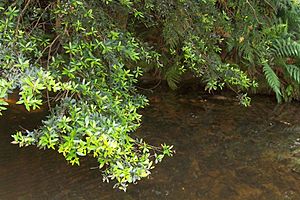Black olive berry facts for kids
Quick facts for kids Black olive berry |
|
|---|---|
 |
|
| Elaeocarpus holopetalus, Blue Mountains National Park, Australia | |
| Scientific classification | |
| Genus: |
Elaeocarpus
|
| Species: |
holopetalus
|
Elaeocarpus holopetalus is a small rainforest tree. People often call it the black olive berry. Other names are mountain blue-berry and mountain quandong.
This tree grows in eastern Australia. You can find it from the Snowy River in the south. It grows all the way up to Chaelundi National Park in northern New South Wales. It likes to grow in high places, often in valleys called gullies.
Elaeocarpus holopetalus often grows near other trees. These include the southern sassafras. You can see them together in places like Errinundra National Park and Blue Mountains National Park. It also grows with the Antarctic beech in areas like Barrington Tops National Park.
What Does It Look Like?
This plant is usually a large bush or a small tree. But some rare ones are very big! They can be 2 meters wide at the bottom. They can also grow as tall as 25 meters. The trunk is straight. It has dark grey or brown bark. The bark is mostly smooth, but has some cracks.
Leaves
The leaves are special because they have jagged edges. This is called being serrated. They are 3 to 7 centimeters long. The top of the leaf is dark green. The underside is a lighter green. You can easily see the veins on the leaves, especially underneath.
One cool thing about this tree is its old leaves. Before they fall off, they turn bright red. This is a sign that they are senescent, meaning they are aging. Many other Elaeocarpus trees do this too.
Flowers and Fruit
White flowers grow in groups called racemes. A raceme is a cluster of flowers along a central stem. These flowers appear in November and December.
The fruit is a black or maroon-colored drupe. A drupe is a fleshy fruit with a hard pit inside, like a cherry. The fruit is about 9 millimeters long. It ripens from March to October. It can be hard to grow new trees from the seeds. But growing them from cuttings works better.
Gallery
-
E. holopetalus in Blue Mountains National Park
-
A mountain stream with orange/red old leaves of E. holopetalus. The other leaves are southern sassafras and Blue Mountains ash.
-
Black olive berry growing as a hemiepiphyte. This means it starts growing on another plant, like this soft tree fern. Then its roots reach the ground. This one is at Devil's Creek, South East Forests National Park.
-
E. holopetalus (on the left) and southern sassafras (on the right) near Nimmitabel
-
A very tall black olive berry tree. It is 25 meters tall at Mount Imlay National Park, Australia.
Further Reading
- Floyd, A.G., Rainforest Trees of Mainland South-eastern Australia, Inkata Press 1989, ISBN: 0-909605-57-2
See also
 In Spanish: Elaeocarpus holopetalus para niños
In Spanish: Elaeocarpus holopetalus para niños







